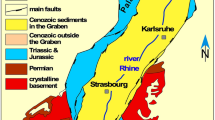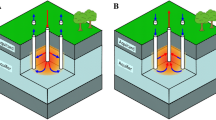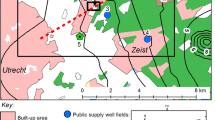Abstract
A modeling study was carried out to evaluate the influence of aquifer heterogeneity, as represented by geologic layering, on heat transport and storage in an aquifer thermal energy storage (ATES) system in Agassiz, British Columbia, Canada. Two 3D heat transport models were developed and calibrated using the flow and heat transport code FEFLOW including: a “non-layered” model domain with homogeneous hydraulic and thermal properties; and, a “layered” model domain with variable hydraulic and thermal properties assigned to discrete geological units to represent aquifer heterogeneity. The base model (non-layered) shows limited sensitivity for the ranges of all thermal and hydraulic properties expected at the site; the model is most sensitive to vertical anisotropy and hydraulic gradient. Simulated and observed temperatures within the wells reflect a combination of screen placement and layering, with inconsistencies largely explained by the lateral continuity of high permeability layers represented in the model. Simulation of heat injection, storage and recovery show preferential transport along high permeability layers, resulting in longitudinal plume distortion, and overall higher short-term storage efficiencies.
Résumé
Une étude par modélisation a été effectuée pour évaluer l’influence de l’hétérogénéité de l’aquifère telle que la stratification géologique, sur le transport et l’accumulation de chaleur dans un système aquifère de stockage d’énergie géothermique à Agassiz, Colombie Britannique, Canada. Deux modèles 3D de transport de chaleur ont été développés et calibrés en utilisant le logiciel de flux et de transport de chaleur FEFLOW comprenant: un domaine type « non stratifié » avec des propriétés hydrauliques et thermiques homogènes ; et un modèle « stratifié » avec des propriétés hydrauliques et thermiques variables attachées à des unités géologiques discontinues représentant l’hétérogénéité de l’aquifère. Le modèle de base (non stratifié) montre une sensibilité limitée aux échelles de toutes les propriétés thermiques et hydrauliques attendues sur le site ; le modèle est plus sensible à l’anisotropie verticale et au gradient hydraulique. Les températures simulées et observées dans les puits révèlent une combinaison d’écran en place et de stratification, avec des incohérence largement expliquées par la continuité latérale des niveaux à perméabilité élevée représentés dans le modèle. La simulation d’injection de chaleur, accumulation et extraction montrent un transport préférentiel le long des couches de grande perméabilité, dont il résulte une distorsion longitudinale du panache et généralement de plus grande capacité d’accumulation à court terme.
Resumen
Se llevó a cabo un estudio de modelación para evaluar la influencia de la heterogeneidad de un acuífero, representada por la estratificación geológica, sobre el transporte y almacenamiento de calor en un sistema acuífero de almacenamiento de energía térmica (ATES) en Agassiz, British Columbia, Canadá. Se desarrollaron y calibraron dos modelos de transporte 3D usando el programa de flujo y transporte de calor FEFLOW incluyendo: un dominio de modelo “no estratificado” con propiedades hidráulicas y térmicas homogéneas; y, un dominio de modelo “estratificado” con propiedades térmicas e hidráulicas variables asignadas a unidades geológicas discretas para representar la heterogeneidad del acuífero. El modelo base (no estratificado) muestra una limitada sensibilidad para los rangos de todas las propiedades hidráulicas y térmicas esperadas en el sitio; el modelo es más sensible a la anisotropía vertical y al gradiente hidráulico. Las temperaturas simuladas y observadas dentro de los pozos reflejan una combinación de colocación de filtros y estratificación, con inconsistencias explicadas mayormente por la continuidad lateral de capas de alta permeabilidad representadas en el modelo. La simulación de la inyección del calor, el almacenamiento y la recuperación muestran un transporte diferencial a lo largo de capas de alta permeabilidad, lo que resulta en una distorsión longitudinal de la pluma, y sobretodo mayores eficiencias del almacenamiento de corto tiempo.
Resumo
Foi realizado um estudo de modelação para avaliação da heterogeneidade aquífera, tal como a representada pela estratificação geológica, no transporte e armazenamento de calor num sistema de armazenamento de energia térmica (SAET) num aquífero em Agassiz, Columbia Britânica, Canadá. Foram desenvolvidos dois modelos 3D de transporte de calor e foram calibrados com base no uso do código de transporte de fluxo e de calor FEFLOW, incluindo: um modelo de domínio “não estratificado” com propriedades hidráulicas e térmicas homogéneas; e um modelo de domínio “estratificado”, com propriedades hidráulicas e térmicas variáveis, representativas de unidades geológicas discretas que representam a heterogeneidade do aquífero. O modelo de base (não estratificado) mostra uma sensibilidade limitada para as gamas de todas as propriedades hidráulicas e térmicas esperadas para o local; o modelo é mais sensível à anisotropia vertical e ao gradiente hidráulico. As temperaturas simuladas e observadas nos furos refletem a combinação da localização dos filtros com a estratificação, com inconsistências largamente explicadas pela continuidade lateral das camadas de alta permeabilidade representadas no modelo. As simulações de injeção, armazenamento e recuperação de calor mostram preferencialmente transporte ao longo das camadas de alta permeabilidade, resultando em plumas de distorção longitudinal, e numa redução global, a curto prazo, das eficiências de armazenamento.
















Similar content being viewed by others
References
Akindunni FF, Gillham RW (1992) Unsaturated and saturated flow in response to pumping of an unconfined aquifer: numerical investigation of delayed drainage. Ground Water 30(6):873–884
Anderson MP, Woessner WW (1992) Applied groundwater modeling: simulation of flow and advective transport. Academic, San Diego, CA, 381 pp
Andersson O (2007) Aquifer thermal energy storage. In: Paksoy HO (ed) Thermal energy storage for sustainable energy consumption. The Netherlands, Dordrecht, Springer, pp 155–176
Baker FG, Pavlik HF (1990) Characterization and modelling of groundwater flow in a heterogeneous aquifer system to evaluate contaminant migration. In: Bachu S (ed) Fifth Canadian/American conference on hydrogeology. National Water Well Association, Westerville, OH
Bartels J, Kabus F (2003) Seasonal aquifer solar heat storage at Rostock-Brinckmanshoe: first operational experience and aquifer simulation. In: Proceedings of Futurestock, 9th International Conference on Thermal Energy Storage. Warsaw, Poland
Bridger DW (2006) Influence of aquifer heterogeneity on the design and modelling of aquifer thermal energy storage (ATES) systems. MSc Thesis, Simon Fraser University, Canada, 193 pp
Bridger DW, Allen DM (2005) Designing aquifer thermal energy storage systems. ASHRAE J 47(9):S32–S38
Bridger DW, Allen DM (2010) Heat transport simulations in a heterogeneous aquifer used for aquifer thermal energy storage (ATES). Can Geotech J 47(1):96–115. doi:10.1139/T09-078
Busheck TA, Doughty C, Tsang CF (1983) Prediction and analysis of a field experiment on a multilayered aquifer thermal energy storage system with strong buoyancy flow. Water Resour Res 19(5):1307–1315
Davis SN (1969) Porosity and permeabiliy of natural materials. In: De Wiest RJM (ed) Flow through porous media. Academic, New York, pp 54–89
Domenico PA (1972) Concepts and models in groundwater hydrology. McGraw-Hill, New York, 405 pp
Eggen G, Vangsnes G (2005) Heat pump for district cooling and heating at Oslo airport, Gardermoen. In: Proceedings of the 8th IEA Heat Pump Conference. Las Vegas, NV, November, May 30–June 2, 2005
Fofonoff P, Millard RC Jr (1983) Algorithms for computation of fundamental properties of seawater. UNESCO Tech Papers Mar Sci 44, UNESCO, Paris, 53 pp
Freeze RA, Cherry JA (1979) Groundwater. Prentice Hall, Englewood Cliffs, NJ
Hall SJ, Raymond JR (1992) Geohydrologic characterization for aquifer thermal energy storage. In: Proceedings of the Intersociety Energy Conversion Engineering Conference. San Diego, CA, August, 1992, pp 75–81
Hazen A (1893) Some physical properties of sands and gravels. 24th annual report, Massachusetts State Board of Health, Boston
Hellstrom G, Sanner K (2000) EED-Earth energy designer user manual, version 2. EED, Lahnau, Germany
Hidalgo JJ, Carrera J, Dentz M (2009) Steady state heat transport in 3D heterogeneous porous media. Adv Water Resour 32(8):1206–1212. doi:10.1016/j.advwatres.2009.04.003
IF Technology (1995) Underground thermal energy storage: state of the art 1994. IF Technology, Arnhem, The Netherlands
Johnson AI (1967) Specific yield: compilation of specific yields for various materials. US Geol Surv Water Suppl Pap 1662-D
Jumikis AR (1962) Soil mechanics. Van Norstrand, New York, 384 pp
Kim J, Lee Y, Yoon WS, Jeon JS, Koo MH, Keehm Y (2010) Numerical modeling of aquifer thermal energy storage system. Energy 35(12):4955–4965. doi:10.1016/j.energy.2010.08.029
Lee KS (2011) Numerical simulation on the continuous operation of an aquifer thermal energy storage system under regional groundwater flow. Energy Sources Part A: Recover Utilization Environ Eff 33(11):1018–1027. doi:10.1080/15567030903330744
Lee KS (2010) A review on concepts, applications, and models of aquifer thermal energy storage systems. Energies 3:1320–1334. doi:10.3390/en3061320
Lo Russo S, Vincenzo Civita M (2009) Open-loop groundwater heat pumps development for large buildings: a case study. Geothermics 38:335–345
Marx R, Nussbicker-Lux J, Bauer D, Heidemann W, Druck H (2011) Seasonal thermal energy stores: design, operation and applications. Chem Ing Tech 83(11):1994–2001. doi:10.1002/cite.201100064
Maynard S (2006) Ground source heat pumps: pros, cons, and experiences. In: Abstracts, Banff Pork Seminar, January 17–20, 2006. Banff, AB, Canada. http://www.banffpork.ca. Accessed January 2006
Moench AF, Garabedian SF, LeBlanc DR (2001) Estimation of hydraulic parameters from an unconfined aquifer test conducted in a glacial outwash deposit, Cape Cod Massachusetts, US Geol Surv Prof Pap 1629
Molz FJ, Melville JG, Parr AD, King AD, Hoff MT (1983a) Aquifer thermal energy storage: a well doublet experiment at increased temperatures. Water Resour Res 19(1):149–160
Molz FJ, Melville JG, Guven O, Parr AD (1983b) Aquifer thermal energy storage: an attempt to counter free thermal convection. Water Resour Res 19(4):922–930
Morris DA, Johnson AI (1967) Summary of hydrologic and physical properties of rock and soil materials, as analysed by the Hydrologic Laboratories of the U.S. Geological Survey 1948–1960. US Geol Surv Water Suppl Pap 1839-D, 42 pp
Paksoy HO, Andersson O, Abaci S, Evliya H, Turgot B (2000) Heating and cooling of a hospital using solar energy coupled with seasonal thermal energy storage in an aquifer. Renewable Energy 19:117–122
Palmer CD, Blowes DW, Frind EO, Molson JW (1992) Thermal energy storage in an unconfined aquifer: 1. field injection experiment. Water Resour Res 28(10):2845–2856
Rehm BW, Groenewold GH, Morin KA (1980) Hydraulic properties of coal and related materials, Northern Great Plains. Ground Water 18(6):551–561
Tsang CF, Busheck T, Doughty C (1981) Aquifer thermal energy storage: a numerical simulation of Auburn University field experiments. Water Resour Res 17(3):647–658
Vail WL, Jenne EV (1994) Optimizing the design and operation of ATES systems. In: Proceedings of the International Symposium on Aquifer Thermal Energy Storage. Tuscaloosa, AL, November 1994, pp 9–13
Vanhoudt D, Desmedt J, Van Bael J, Robeyn N, Hoes H (2011) An aquifer thermal storage system in a Belgian hospital: long-term experimental evaluation of energy and cost savings. Energy Build 43(12):3657–3665. doi:10.1016/j.enbuild.2011.09.040
WASY (2005) FEFLOW 5.2. Finite element subsurface flow & transport simulation system. WASY, Berlin, Germany
Witte HJL, van Gelder GJ, Spitler JD (2002) In situ measurement of ground thermal conductivity: the Dutch perspective. ASHRAE Transact 108(1):263–272
Xue Y, Xie C, Li Q (1990) Aquifer thermal energy storage: a numerical simulation of field experiments in China. Water Resour Res 26(10):2365–2375
Acknowledgements
The authors wish to acknowledge Agriculture and Agri-Food Canada, in particular Scott Maynard, for providing access to the Agassiz ATES system. We also wish to thank the three anonymous reviewers for their very helpful comments for improving this paper. This research was supported, in part, through a Natural Sciences and Engineering Research Council (NSERC) Discovery Grant.
Author information
Authors and Affiliations
Corresponding author
Additional information
Published in the theme issue “Hydrogeology of Shallow Thermal Systems”
Rights and permissions
About this article
Cite this article
Bridger, D.W., Allen, D.M. Influence of geologic layering on heat transport and storage in an aquifer thermal energy storage system. Hydrogeol J 22, 233–250 (2014). https://doi.org/10.1007/s10040-013-1049-1
Received:
Accepted:
Published:
Issue Date:
DOI: https://doi.org/10.1007/s10040-013-1049-1




